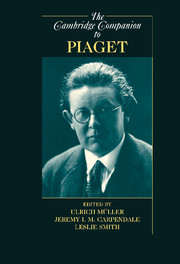Book contents
- Frontmatter
- 1 Introduction: Overview
- 2 The Historical Context Of Piaget’s Ideas
- 3 Piaget’s Developmental Epistemology
- 4 Piaget’s Biology
- 5 On the Concept(s) of the Social in Piaget
- 6 Piaget on Equilibration
- 7 Constructive Processes: Abstraction, Generalization, and Dialectics
- 8 Piaget and Method
- 9 Infancy
- 10 Childhood
- 11 Adolescence
- 12 Piaget’s Theory of Moral Development
- 13 Piaget’s Enduring Contribution to a Science of Consciousness
- 14 Piaget and Affectivity
- 15 Piaget’s Pedagogy
- 16 Piaget in the United States, 1925-1971
- 17 The Mind’s Staircase Revised
- 18 Dynamic Development: A Neo-Piagetian Approach
- Index
15 - Piaget’s Pedagogy
Published online by Cambridge University Press: 28 March 2010
- Frontmatter
- 1 Introduction: Overview
- 2 The Historical Context Of Piaget’s Ideas
- 3 Piaget’s Developmental Epistemology
- 4 Piaget’s Biology
- 5 On the Concept(s) of the Social in Piaget
- 6 Piaget on Equilibration
- 7 Constructive Processes: Abstraction, Generalization, and Dialectics
- 8 Piaget and Method
- 9 Infancy
- 10 Childhood
- 11 Adolescence
- 12 Piaget’s Theory of Moral Development
- 13 Piaget’s Enduring Contribution to a Science of Consciousness
- 14 Piaget and Affectivity
- 15 Piaget’s Pedagogy
- 16 Piaget in the United States, 1925-1971
- 17 The Mind’s Staircase Revised
- 18 Dynamic Development: A Neo-Piagetian Approach
- Index
Summary
Education, for most people, means trying to lead the child to resemble the typical adult of his society (whereas) for me, education means making creators, even if there aren't many of them, even if one's creations are limited by comparison with those others.
(Piaget, 1977/1980, p. 132)INTRODUCTION
Education is a complex business and one of its parts is pedagogy, that is, the process of education in which knowledge or skills are imparted through teaching. My chapter on Piaget's pedagogy (PP) runs directly into a problem. Piaget's work is commonly interpreted as a pedagogy-free zone with teaching adding next to nothing to children's development. In this chapter, I want to do three things. First, I revisit the educational critique of Piaget's work to show that this critique is flawed - good evidence shows that PP works well in practice. Then I provide PP's re-analysis to show that its main principles are theoretically alive and well. Finally, the last section contains a review of my argument with pointers to future directions.
PIAGET'S PEDAGOGY IN PRACTICE
Piaget's work has attracted attention with regard to its educational potential and promise. The predominant view, however, has been that it failed to deliver; that is, the outcome of the educational critique has commonly been negative. In this section, I review this negative critique and then state a counter-argument to show that it is flawed.
- Type
- Chapter
- Information
- The Cambridge Companion to Piaget , pp. 324 - 343Publisher: Cambridge University PressPrint publication year: 2009
- 3
- Cited by



